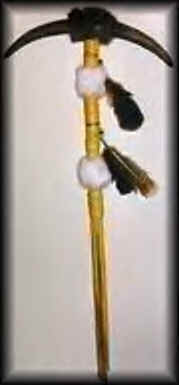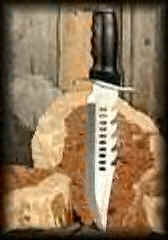Weapons of the Barrens...


Horned Axe Sleen knife


Sleen knives Temwood bow


War Axe Lance
The kaiila lance is used in hunting kailiauk as well as in mounted warfare. It is called the kaiila lance because it is designed to be used from kaiilaback. It is to be distinguished in particular from the longer, heavier tharlarion lance, designed to use from tharlarionback, and often used with a lance rest, and the smaller, thicker stabbing lances used by certain groups of pedestrian nomads. The kaiila lance takes, on the whole, two form, the hunting lance and the war lance. Hunting lances are commonly longer, heaveir and thicker than war lances. Too, they are often undecorated, save perhaps for a knot of the feathers of the yellow, long-winged, sharp billed praire fleer, or as it is sometimes called, the maize bird, or corn bird, consdidered by the red savages to be generally the first bird to find food.
The point of the hunting lance is usually longer and narrower than that of the war lance, a function of the depth into which one must strike in order to find the heart of the kailiauk. The shaft of the kaiila lances are black, supple and strong; they are made of tem wood, a wood much favored on Gor for this type of purpose. Staves for the lances are cut in the late winter, when the sap is down. Such wood, in the long process of smoking and drying over the lodge fire, which consumes serverl weeks, seasoning the wood, and killing any insects which might remain in it, seldom splits or cracks. Similiarly, old-growth wood, or second-growth wood, which is toughter , is preferred over fresher, less dnse first growth, or new growth, wood.
After drying the shafts are rubbed with grease and straightened over the heat of the fire. Detailed trimming and shaping is accomplished with a small knife. rubbing with sandstone supplies a smooth finish. The Head, of metal, or of bone, or stone, with sinew or rawhide, and also sometimes with metal trade riviets, is then mounted on the lance. Lastly, grips, and loops, and decorations, if desired, are added. The sinew and rawhide, before being bound on the lance are soaked with hot water. The heated water releases a natural glue these substances, and the water itslelf, of course, produces a natural shirinking and contraction in the drying. The mounting, thus, is extremely solid and secure. The tarn lance, it might be mentioned, as is used by the red savages who have mastered who have mastered the tarn, is, in size and shape, very similar to the kaiila lance. It differs primarily in being longer and more slender. These lances are used in a great variety of ways, but the most commonmethod is to thrust one`s wrist through the wrist loop, grassp the lance with the right hand, and anchor it beneath the right arm. This maximuzes balance, control and impact. With the weight of a hurtling kaiila behind the thrust such a lance can be thrust through the body of a Kailiauk. To be sure, the skillful hunter will strike no more deely than is necessary, and his trained kaiila will slow its pace sufficiently to permit the kailiauk to draw its own body from the lance. This permits the lance to be used again and again in the same hunt.
"Notice the manner in which the lances are held by the mounted hunters," said Kog.
"the first one," said Samos, "has his lance in the attack position."
"He, then, will be the first to die," I said.
"Of course," said Kog.
One of the other mounted hunters held his lance in his right hand, its butt resting on his thigh. From this position he could rapidly bring the lance to the attack postion. He was accordingly, the second fellow with whom the man must deal.
A third mounted hunter held the lance across his body, it resting in the crook of his left arm. He was the third fellow to reckon with. The other two mounted hunters still wore their lances in their shoulder loops, slung across their back.
The might be saved to last.
"The man removes his bow from the fringed, beaded bow case," said Kog. "He strings the bow ." The bow, of course , is left unstrung until it is ready to be used. This conserves the resilience of the wood and the tightness and strength of the sinew string. "From his quiver," said Kog, "he extracts six arrows. Three he hods, with the bow, in his left hand. One he fits to the string. Two he holds in his mouth."
"The first mounted hunter is prepared to attack," said Samos.
"The man, on his snowshoes descends the slope between himself and his enemies," said Kog, "his arrow to the string"
The range and striking power of the small bow, while not negligible, do not comare with that of the peasant bow, or long bow. The red savage, accordingly, whenever possible, attempts to maximize the posssibilites of an effective hit by decreasing the distance between himself and the target. This fits in, incidentally, with his glorification of close combat.
The most highly regarded battle exploit among most tribes for which the highest honors are accorded, is not to kill armed enemy but to touch or strike one with the open hand.
The more danger and risk that is involved in a deed, on the whole, the greater is the concomitant glory of accomplishing it.
Killing the enemy, thus, in the heraldry of the red savages, ranks far beneath the besting of the enemy, and in a way that supposedly demonstrates one`s greater prowess and courage.
It is thus understandable that touching and armed enemy with the open hand counts among most tribes as first coup. The second and the third man to accomplish such a deed would then receive second coup and third coup. Killing an enemy with a bow and arrow from ambush, on the other hand, might be counted as only a fight or seventh coup.
Needless to say the counting of coup, which is reflected in the feathers and adorments to which on is entitled, is a matter of great importance to the red savages. Indeed, there are also, in many tribes, practical considerations which also become involved in these matters. For example, it is unlikely that one can advance within a tribe, or become a leader or chieftain, unless one has frequently counted coup. Too, in many tribes, a man who has not counted coup is not permittedto mate. In other tribes, such a man, if he is over twenty five is permitted to mate, but he is not allowed to paint his mate`s face. Thus will her shame before the other women be made clear.
The institution of counting , or tallying, coup has several obvious effects on the structure and nature of the society of the red savages. In particular, it tends, on the whole, to arerange social hierarchies in such a way that the soceity is orientated towards aggressiveness and warfare, features which tend to protect and preserve, in an almost natural harmony and balance, delicate relationships between food supplies, territories and populations. Viewed in this manner tribal warfare may be seenas an example of intraspecific aggresson, with its attendant consequences in decentralizing and refining diverse populations. Too, if one regards these things as of ainy interest, the counting of coup and intertribal warfare lends color, excitement and zest to the lives of the red savages.
They live in a world in which danger is not unkown. Surelythey could live otherwise, but theyhave not chosen to do so.
They live with the stars and the winds, and the kaiila and kailiauck. They have not chosen to revere the fat bellied, beer drinking gods of more sedentary peoples. Too, of course it should be noted that the counting of coup tends, tends statistically, to ensure that it is the stronger and healthier, the more alert, the more intelligent and sharper sensed who will reproduce themselves. This is in marked contrast to certain societies where it is the healthiest and finest who are sent off to war while the inferior and defective remain behind in safety, making money and Multiplying themselves.
In most tribes, incedentally, a man who refuses to go on the warpath is put in women`s clothes and give man a woman`s name. He must live as a woman. Henceforth he is always referred to in the female gender. Needless to say , she is never permitted to mate. Sometimes she must even serve the members of a warriors society, as a captive female.
Interestingly enough, whites stand outside of the coup structure. This is something that fw of them will object to. It seems they are simply not regarded, on the whole, as being suitable foes or foes worthy enough to stand within the coup structure. It is not that red savages object to killing them. It is only theat they do not take pride, commonly, in doing so.
Similarly a man of the high cities would not expected to be publicly rewarded for having speared a tark or slain an urt.
Accordingly the red savage will seldom go out of his way to slaya white person; he commonly sees little profit in doing so; in killing such a personhe is not entitled to
count coup.
"The man, now" said Kog, "is not fifty feet from the mounted hunters. Inthe soft snow he has descended the slope silently."
"Surely the dark guest, as we may call him, that crouching behind the kailiauck, has seen him."
"Of course," said Kog, "but he has geven no sign,"
"No sign," I said, "which was read by the mounted hunters,"
"Yes," said Kog. His lips drew back, over his fangs. There are always signs. It is only a question of their detectabitlity.
They are as small , sometimes, as the dilation of a pupil.
"The bow is drawn," said Kog.
The small bow has many advangages. High among these is the rapidity with which it may be drawn and fired. A skilled warrior, in the Gorean gravity, canfire ten arrows into the air, the last leaving the bow before the first has returned to the earth. No Gorean weapon can match it in its rate of fire.
At close range it can be devastating. Two further advantages of the small bow that might be mentioned are its maneuverability and its capacity to be concealed, say beneaht a robe. It can be easily swept from one side of the kaiila to the other. In this type of combat, incidentally, it is not unusual for the warrior to shield himself behind the body of his racing kaiil, and, circlingthe enemy, rise up, suddenly, to fire over the animal`s back and a fist in its silken neck hair, or an arm thrust through a leather throat loop, provide the leverage needed for these feats
savages of Gor Pg. 42-47
 click
here to return to main page
click
here to return to main page